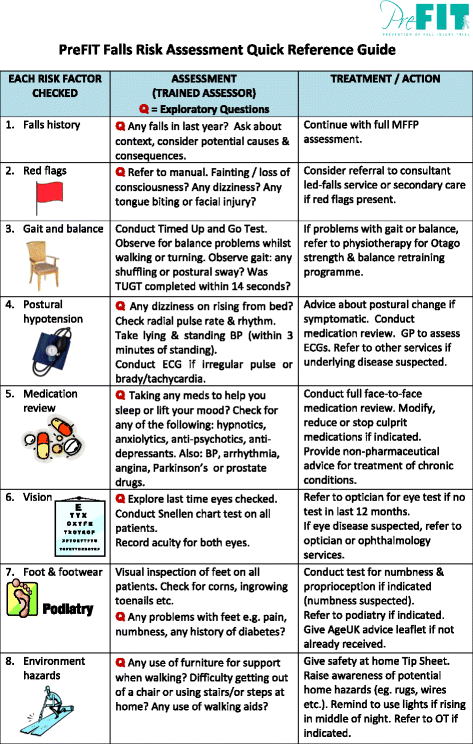The Ultimate Guide To Dementia Fall Risk
Wiki Article
Our Dementia Fall Risk Diaries
Table of ContentsDementia Fall Risk Can Be Fun For EveryoneSome Known Incorrect Statements About Dementia Fall Risk Dementia Fall Risk Can Be Fun For Anyone6 Easy Facts About Dementia Fall Risk ExplainedThe smart Trick of Dementia Fall Risk That Nobody is Discussing
The FRAT has three areas: drop threat standing, risk factor checklist, and action strategy. A Fall Danger Condition includes data regarding background of current falls, medications, psychological and cognitive status of the person - Dementia Fall Risk.If the person ratings on a danger aspect, the corresponding number of factors are counted to the patient's autumn threat score in package to the far right. If an individual's fall threat score completes five or higher, the individual is at high risk for drops. If the person scores just four factors or lower, they are still at some threat of dropping, and the registered nurse should utilize their finest clinical evaluation to take care of all loss threat variables as component of an all natural care plan.
These common techniques, in basic, aid develop a risk-free environment that minimizes unintentional falls and delineates core preventative steps for all people. Signs are essential for people at risk for falls.
Not known Details About Dementia Fall Risk
Wristbands must include the client's last and very first name, day of birth, and NHS number in the UK. Only red shade ought to be used to signify unique person condition.
Things that are also much might require the individual to connect or ambulate unnecessarily and can possibly be a danger or add to drops. Helps prevent the person from heading out of bed with no aid. Nurses react to fallers' call lights more rapidly than they do to lights started by non-fallers.
Visual problems can greatly create drops. Maintaining the beds closer to the flooring minimizes the risk of falls and serious injury. Putting the cushion on the floor dramatically lowers loss threat in some healthcare setups.
What Does Dementia Fall Risk Do?
Patients that are tall and with weak leg muscle mass who attempt to rest on the bed from a standing placement are most likely to fall onto the bed due to the fact that it's too low for them to reduce themselves securely. Likewise, if a high individual efforts to stand up from a reduced bed without help, the client is likely to drop back down onto the bed or miss the bed and fall onto the floor.They're designed to advertise here are the findings prompt rescue, not to stop drops from bed. Aside from bed alarm systems, increased supervision for risky patients additionally might aid avoid drops.

Clients with a shuffling gait increase fall opportunities significantly. To reduce loss threat, footwear ought to be with a little to no heel, thin soles with slip-resistant tread, and sustain the ankle joints. Recommend client to use nonskid socks to stop the feet from moving upon standing. Motivate clients to put on appropriate, well-fitting shoesnot nonskid socks for ambulation.
8 Easy Facts About Dementia Fall Risk Described
In a research study, homes with sufficient illumination record less drops (Ramulu et al., 2021). Enhancement in illumination at home may lower fall rates in older grownups.
Caretakers work for ensuring a safe and secure, protected, and safe environment. Studies demonstrated very low-certainty proof try here that sitters lower loss risk in acute treatment medical facilities and only moderate-certainty that options like video tracking can lower sitter usage without boosting fall threat, suggesting that sitters are not as useful as originally thought (Greely et al., 2020).
What Does Dementia Fall Risk Do?
-copy-5.jpg)
Enhanced physical fitness decreases the risk for falls and restricts injury that is sustained when autumn transpires. Land and water-based workout programs may be similarly valuable on balance and gait and thus decrease the threat for falls. Water exercise might add a positive advantage on balance and stride for women 65 years and older.
Chair Increase Exercise is a simple sit-to-stand workout that helps enhance the muscle mass in the upper legs and butts and enhances flexibility and self-reliance. The objective is to do Chair Increase exercises without making use of hands as the client becomes more powerful. See sources section for a thorough guideline on just how to do Chair Surge exercise.
Report this wiki page